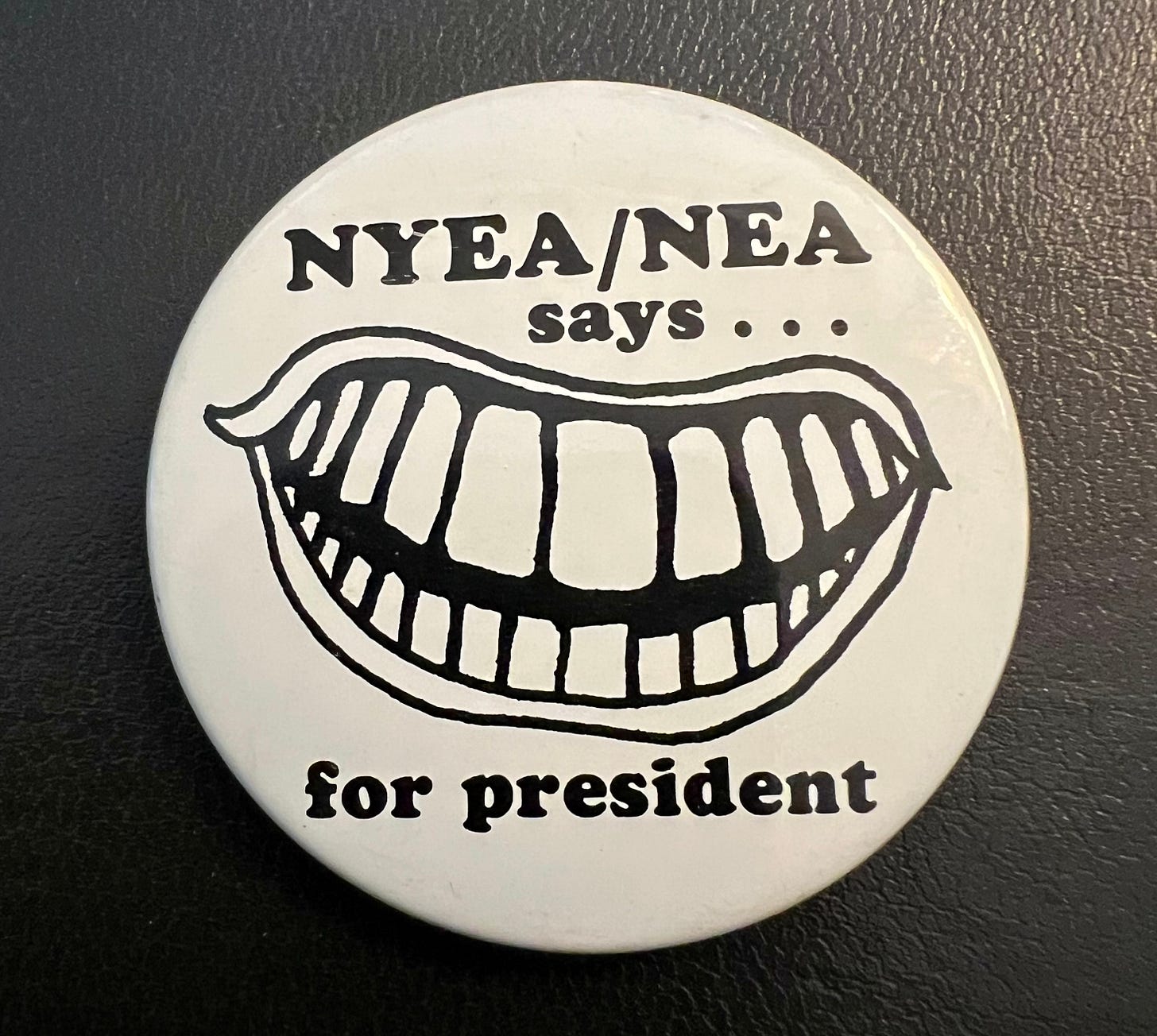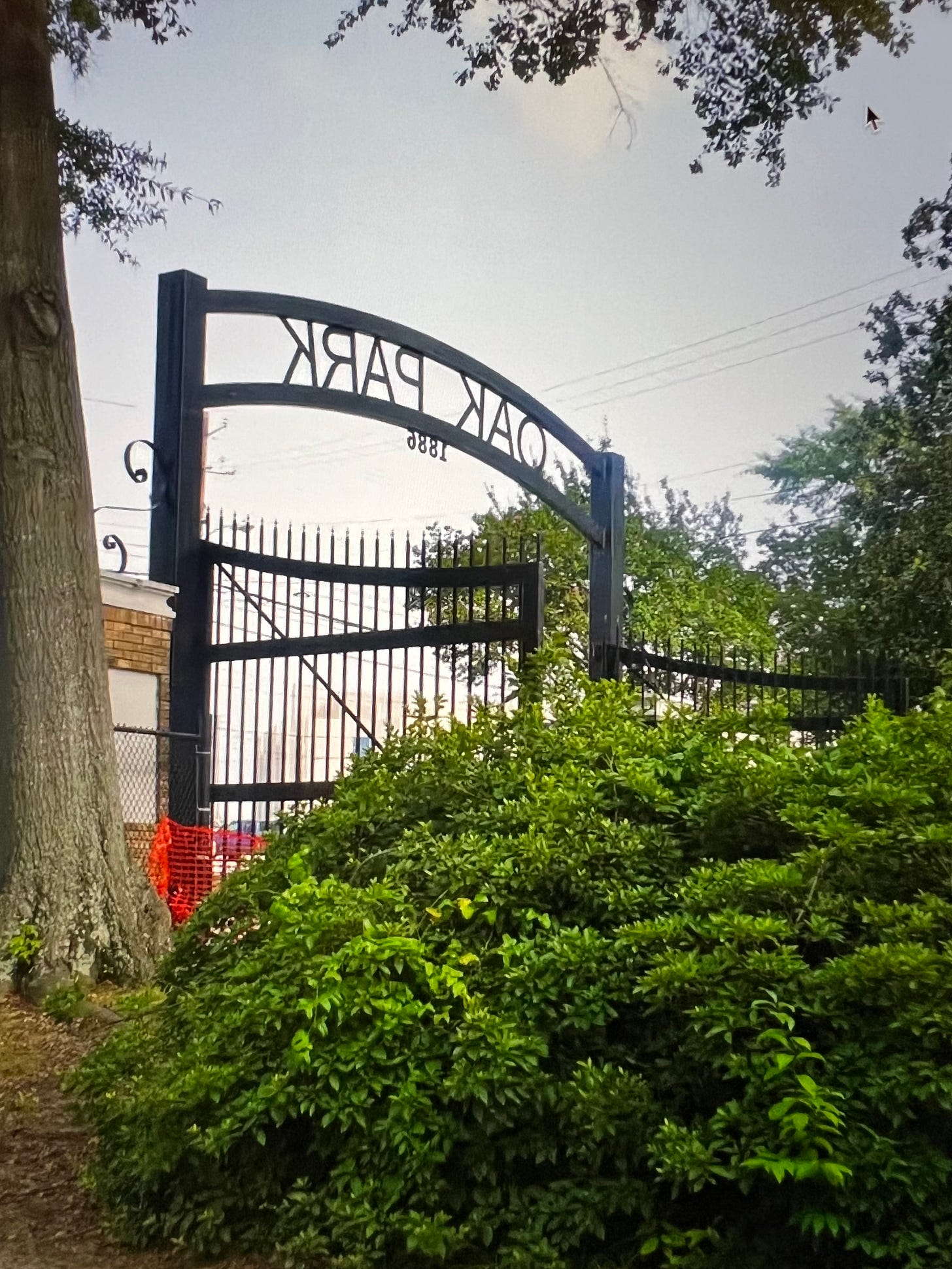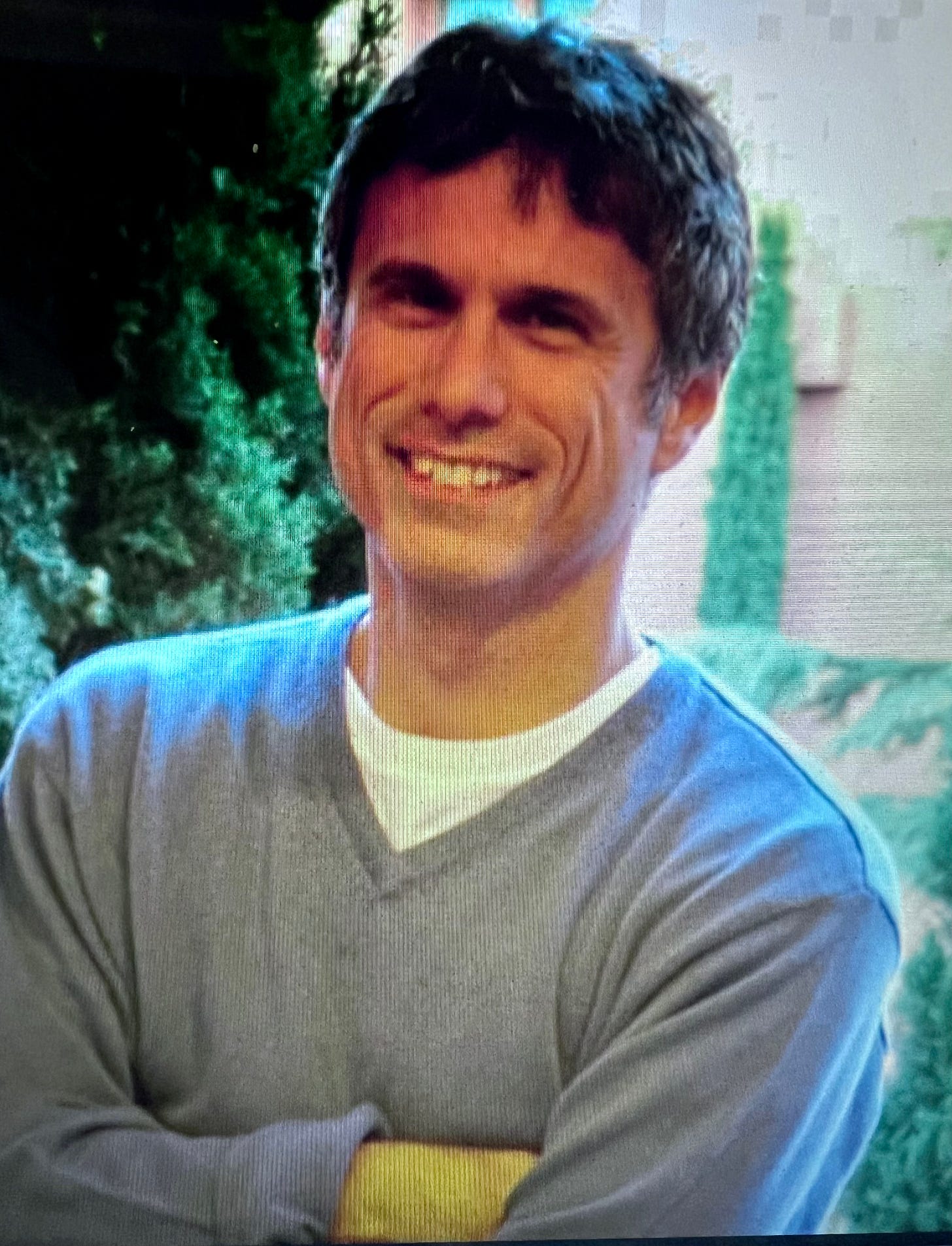I’m having a tough time putting my head around the death of a long-time friend, boss, mentor, adversary, colleague, confidant, and Yoda-like wise man.

(The concept for this 1980 Jimmy Carter campaign button was pure John Dornan.)
I’m having trouble wrapping my head around the fact that John Dornan is dead.
Five years older than I, John was an important part of my life for 50 + years.
John Dornan was my boss, my foil, my mentor, my counselor, my colleague, my confidant, my cheerleader and my friend, not always in that order, with varying degrees of intensity. As our lives advanced in different directions, and different parts of the country, the intensity of my admiration for him, for who he was and was not, only increased.
Our paths first crossed, when I was less than two years out of college and working as a field organizer for the teachers union in upstate New York. John was part of a team of trainers—steeped in Labor history and the labor organizing philosophy and techniques of the legendary Saul Alinsky—who taught us “field reps,” how to get teachers to join the union.
That was not an easy task in hot beds of Right Wing Richard Nixon Republicanism like Palmyra, New York, where thousands of Mormons flocked each year to visit the birthplace of their sainted founder, Joseph Smith. In fact, I was accused of being a “Communist” by a male high school teacher, when I made a pitch for Palmyra’s teachers to join the union.
For political activists like myself, who marched against the Vietnam War, and for Civil Rights, labor organizing for the teachers’ union was sacred work, with Nixon in the White House, and the soon-to-be-imprisoned authoritarian John Mitchell as Attorney General. To us, John Dornan, and the other Alinsky acolytes he traveled with, were our Joseph Smiths.
“Oh, no,” I could hear Dornan mutter, shaking his head with a smirk. He’d want nothing to do with a comparison to a Saint, especially a Mormon Saint, who’d have no tolerance for John’s lust for life.
A few years later, I was working for NEA’s large, Prince George’s County, Maryland affiliate, and John was already in a senior position at the Coalition of American Public Employees, working with the Civil Rights leader, James Farmer. I was looking to return to New York—where I was born, raised and went to college– and John was putting together a National Education Association team to join him in Albany, NY, to make a direct challenge to Albert Shanker’s tyrannical grip on the teacher union movement.
Dornan greeted me on the expansive patio of his stylish DC apartment, and we drank wine and talked about politics and education into the night, and I told him how, three years later, I was still angry at Shanker for supporting the Vietnam War Hawk, “Scoop” Jackson in 1972, over George McGovern for President.
I don’t remember how I got back to my Maryland condo that night, but I knew I liked this bright, feisty guy, and saw in him an easy melding of class, grace, intelligence, and a political passion for the underdog. We’d go on to work together for the next five years and remain friends for the next 50.
John was the Director of Communications for the NEA in New York, and I was his Editor-in-Chief of our statewide publication “The Advocate.” On the job, he was a creative person’s ideal boss—encouraging, nurturing, supportive of wild ideas—but when I became active in the Staff union, and squared off against his management team, both of our competitive natures, made us adversaries.
Our male ego game-playing continued on the tennis court, where we were evenly matched, building mutual respect for each other’s toughness and refusal to ever give up. I was young, full of myself, and self-righteously obnoxious, and delighted in testing how far I could push Dornan at work, sometimes feeling as if I were daring an older brother to rein me in. Time and time again, John surprised me, always backing me up, and standing behind decisions that might have made other supervisors uncomfortable. Two specific incidences come to mind.
One involved a crusading story I wanted to do exposing sweatshop conditions at a cap and gown facility in Albany, NY, at a building where the family of one of my coworker’s had a financial interest. The co-worker complained loudly to Dornan, and to our Executive Director Pat Orrange–one of the few female union leaders in the country–who would later become John’s life partner. Orrange, an effusive & charismatic Buffalo native, and Dornan, gave unwavering support for my reporting—and for what the story exposed. It was, they said, the right thing to do, and reflected our values.
Another, tougher call, involved the 1980 Presidential Campaign, when the NEA and its affiliates were supporting Jimmy Carter for re-election. Carter had delivered on his promise to create the first federal Department of Education in American history, and the NEA, appropriately so, felt an obligation to support him for that enormous achievement and his strong support for public education.
John Dornan, always bubbling with creative ideas, conceptualized the button design that would mark the campaign for Carter’s re-election in New York State. It contained a peanut-shaped mouth full of grinning teeth, with the typeface saying: “NYEA/NEA says… (teeth) for president. The idea was quintessential Dornan: irreverent, clever, smart, fun and to the point.
Despite Dornan’s going all-in for Carter—and working with my future boss Mario Cuomo, who headed Carter’s New York State campaign—I was out there, as a leader in the Albany County Progressive wing of the Democratic Party, campaigning for Teddy Kennedy in the NYS Democratic Primary against Carter, which Kennedy won handily in the Spring of 1980. Not once did John Dornan come down on me for opposing the NEA’s choice, even though Al Shanker’s AFT was backing Kennedy, and opposing Carter, and the NEA was paying my salary. John had every right to pull me back into the NEA/Carter fold, but he never exercised that option, and my respect for Dornan only grew.
In fact, over the years, he made clear his mutual respect for me, without being overtly dramatic or too demonstrative, which was not part of Dornan’s DNA. John introduced me at one NEA Convention, as “our Communications scholar,” after I completed my Masters Degree in Communications. He recommended me to succeed him to teach in the Labor Studies Program for Cornell University, a position which I prized and continued to do for 22 years, always making sure I used John’s recommended Rules for Radicals by Saul Alinsky, as one of my required texts. Each time I picked up the book, to read a phrase or a bullet point to my class, I was reminded of Dornan’s devotion to Alinsky’s Rules.
Our lives fast forwarded to 2016, when Hillary Clinton ran for President against Donald Trump, and North Carolina, with 15-electoral votes, loomed large in the Democrats strategy to win the White House. John and Pat were now living in Raleigh, following their long and illustrious careers in education. Both were deeply involved in the political, educational and social justice issues across the State of North Carolina. I wanted to come to a key “swing state” to do voter protection for the Clinton campaign against the Trump troglodytes, and John Dornan and Pat Orrange, welcomed me to fight the good fight alongside them, once again..
I arrived in Raleigh in early October, 2016, bought a return airline ticket for the day after Election Day, and settled in for what I hoped would be three weeks of good solid, voter protection work, all on my own dime. John and Pat had arranged for me to stay with a friend of theirs who had a spare room, and paved the way for me to be part of the Clinton campaign’s North Carolina operation.
John Dornan and Pat Orrange and their friend Millie Ravenel, welcomed me with open arms, to the North Carolina campaign. The first week went well, participating in several voter protection training sessions across the State, and working out of Clinton’s Raleigh campaign headquarters, making phone calls. Then something strange happened.
A little-used GOP back office in Chapel Hill, a heavily Democratic Area, was firebombed. What made the firebombing immediately suspicious–aside from the fact that the Orange County, NC, GOP is virtually non-existent in elections — was that Donald Trump began “Tweeting” about the bombing immediately after it happened, blaming “Hillary Clinton supporters” and “Democrats” for the crime, without any shred of evidence.
In fact, every single Democrat or Hillary supporter I’d encountered in North Carolina was gravely concerned about doing everything the law provided to prevent violence in the election. It was the reason many of us were willing to put our lives on the line in that open-carry, gun-loving state.
Trump’s feigned hysteria carried the stench of another famous fire: the one in the German Reichstag, started by the White Nationalist Party of Adolph Hitler during the German national elections of 1933, and blamed on the Communists. The Reichstag Fire, was immediately pounced upon by Nazi leaders as “evidence” of terror from the left, and the need for the authoritarian rule which their leader promised. It was instrumental in leading to the election of Hitler as German Chancellor. No evidence was ever produced to support the Nazis’ wild claims.
I wrote about this suspicious fire for my blog, and the article was picked up by my friend, the writer Joe Conason, in his The National Memo, an on-line publication with about 300,000 readers nationwide.
When the Clinton campaign people found out about my article, entitled “Trump’s Reichstag Fire in North Carolina,” they demanded that I either take the article down (as if that were possible after it went viral nationally) or leave the campaign—for which I was volunteering on my own time, and at my own expense.
I refused. I told them they knew I was a writer, when I volunteered for them, and that I would not censor myself, especially since everything I wrote was so supportive of the campaign. The Clinton campaign’s 28-year old communications director in North Carolina, clueless about what the Reichstag Fire was, told me I was too militant, and had me escorted out of the building.
So, a few weeks before the Presidential election of 2016, I found myself adrift in Raleigh, N.C, 2500 miles from my California home, “fired” from a cowering campaign I was volunteering for, with a return plane ticket back to the West Coast the day after election day, still several weeks off. I got into the Red Toyota pick-up truck I was renting, and drove, almost instinctually, over to John & Pat’s house, where I found John Dornan home. He was my port in the storm.
“You’re not going to believe this,” I told him, as he opened the door, and I proceeded to tell him what had just transpired.
“Are you serious?” John asked, shaking his head in disbelief. “Are you serious?” I can still hear John’s distinctive voice and emphasis of incredulity.
Then, John Dornan and I sat on the beautiful back deck of his house in a lovely section of North Carolina’s Capitol city, and drank wine all afternoon, looking out at the lush greenery of his yard, with some of the majestic trees beginning to try on their fall clothes, and we talked about the trajectory of politics and our lives, and the weakness of the Clinton campaign, and the impossible insanity of Trump becoming President, and I was transported back to the spacious patio of his DC apartment some 40 years earlier, where I felt safe and protected from anything that could come our way, since John had a far more pragmatic and straightforward look at things than I did, and instinctually knew how to approach each situation with a sense of humor, and his despair in check, just enough to allow his natural sense of hope, and humanity, light the way.
He needed no translation when after each good person’s death I’d say “All the wrong people are dying,” especially when there were so many other prospects to choose from. And, now, it’s happened again, to the wrong person, leaving an irreparable rip in the lives of those who loved him.
Damn it, Dornan, I’m gonna miss you. You lived longer than you ever expected; longer than your father did, and more years than Saul Alinsky, who died at age 63.
But in your wry wisdom you left us with a legacy straight out of Rules for Radicals, fittingly, from the last paragraph of the last page:
“When Americans can no longer see the stars, the times are tragic. We must believe that it is the darkness before the dawn of a beautiful new world; we will see it when we believe it.”
I re-read that line, on the day after I learned of Dornan’s death, and was stunned that it was exactly my mother’s mantra: “Always darkest before the dawn.” A 92-year Polio survivor, and a devout Catholic, my mother was the ultimate organizer of hope, everlasting.
You made me a believer, once again, John, in the darkest of times, and left us forever with the image of Jimmy Carter’s grinning teeth lighting-up your own mischievous, Yoda-like smile.
###




